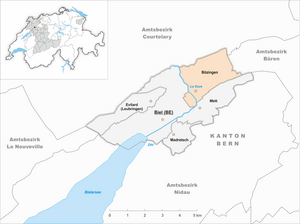Bozingen
|
Bözingen district of Biel / Bienne |
|
|---|---|
| Coordinates | 587 085 / 222 592 |
| height | 446 m |
| surface | 5.53 km² |
| Residents | 6623 (December 31, 2015) |
| Population density | 1198 inhabitants / km² |
| Incorporation | 1917 |
| Post Code | 2504 |
| Source: Federal Statistical Office | |
Bözingen ( French Boujean ) is the area the largest district ( district ) of the city of Biel / Bienne . The formerly independent municipality of Bözingen was incorporated into Biel in 1917.
location
Bözingen is located at the eastern end of the city of Biel at the exit of the Taubenloch Gorge .
history
Located in the area of the Prince-Bishop of Basel , Bözingen belonged to the Meiertum of the city of Biel from 1388. Administratively, Bözingen was subordinate to the Biel Council, which elected and sworn in Ammann at the suggestion of the municipality . Biel's gallows was in Bözingen.
The Schüss which limited the Episcopal Kastvogtei Biel in the 13th century, told Bözingen into two parts: upper and lower village. These two districts had partly different legal forms.
In 1634 the mill at the exit of the Taubenloch Gorge was supplemented by a wire pull.
From 1798 to 1813 Bözingen was part of France. In 1815 the area of the former prince-bishopric was united with Bern. Bözingen became a rural municipality in Bern. Definitive constitution 1823.
For a long time Bözingen was a typical street village , the development of which stretched along the cantonal road Biel – Solothurn. In 1874, a major fire destroyed 30 buildings. After that, the village changed its face, mainly because of the decline in agriculture. The watch industry in Biel had an impact on Bözingen. Workers from Bözingen found employment in Biel. But watch workshops were also set up in Bözingen. In 1917 the two communities of Biel and Bözingen merged.
traffic
The cantonal road Biel – Solothurn runs through the village. Until Reuchenettestrasse was built in 1858, traffic in the direction of the Jura also touched the place, with the route leading on the eastern slope and above the Taubenloch Gorge. The old route goes back to the Romans and is therefore called the Römerweg.
The Biel-Solothurn railway line, which opened in 1857, did not affect the community. The Mett-Bözingen station (now called “Biel Mett”), which was only opened in 1895, was located in the municipality of Mett .
The place was opened up by the Biel tram in 1877 , first as a Rösslitram , later as an electric tram. Their depot was on Bözinger soil. The tram line was replaced by a trolleybus line in 1948.
The wire works and the sleeper works were opened from 1909 to 1991 with a narrow-gauge freight railway from the Mett station.
Attractions
literature
- Tobias Kaestli: Bözinger story, published by the Burgergemeinde Bözingen, Biel 2016.
- Marcus Bourquin: From the history of Bözingen, in: Die Burgergemeinde Bözingen, history and present, Bözingen 1989.
Web links
- Margrit Wick-Werder: Bözingen. In: Historical Lexicon of Switzerland .
- Excursion destinations:
- Taubenlochschlucht : Wild and romantic Schüss gorge with an insight into the erosion activity of the river
- Tierpark Bözingen : native animal species (in the outdoor area)
- Bözingenberg : View of Lake Biel, Lake Murten and Lake Neuchâtel, the Central Plateau and the Alps, 930 meters above sea level
The shot
Bözingen in 1836; in the background Biel, Lake Biel and St. Petersinsel





